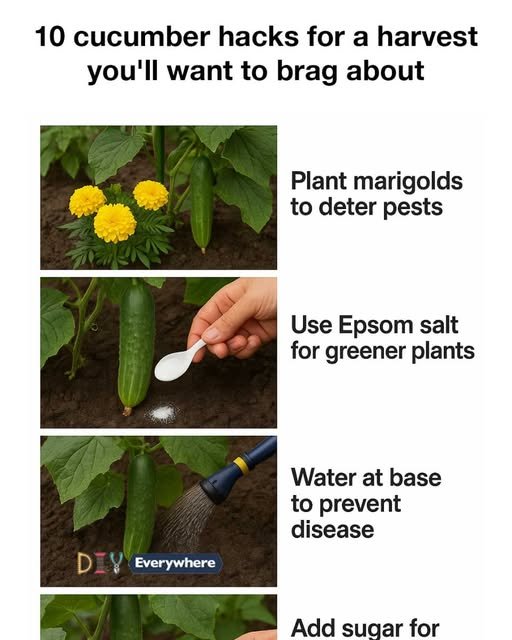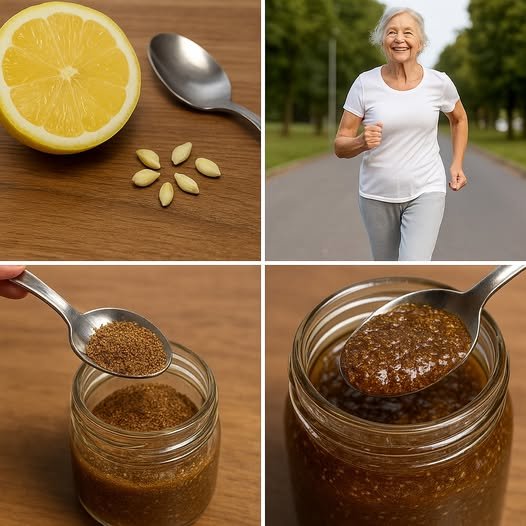Cucumbers are a beloved staple in many gardens, known for their crisp texture and refreshing taste. However, achieving a bountiful harvest that you can truly brag about requires more than just planting seeds and hoping for the best. With the right techniques and a little bit of insider knowledge, you can transform your cucumber patch into a thriving oasis of green.
Whether you’re a seasoned gardener or a novice looking to improve your yield, these ten cucumber hacks will help you cultivate a crop that’s not only abundant but also delicious. From pest control to soil management, each tip is designed to optimize your growing conditions and ensure your cucumbers are the envy of the neighborhood.
1. Plant Marigolds to Deter Pests
Marigolds are more than just a pretty flower; they are a powerful ally in the garden. Planting marigolds around your cucumber plants can significantly reduce the presence of harmful pests. The strong scent of marigolds acts as a natural deterrent to nematodes and aphids, which are common cucumber pests.
To maximize their effectiveness, plant marigolds in a border around your cucumber patch, spacing them about 6 to 12 inches apart. This not only creates a beautiful garden aesthetic but also forms a protective barrier that helps keep your cucumbers safe from unwanted invaders.
2. Use Epsom Salt for Greener Plants
Epsom salt is a gardener’s secret weapon for lush, green foliage. Rich in magnesium, Epsom salt helps improve photosynthesis and overall plant health. For cucumbers, this means stronger vines and healthier leaves.
To use Epsom salt, dissolve 1 tablespoon in a gallon of water and apply it to the base of your cucumber plants every two weeks. This simple addition to your gardening routine can lead to noticeable improvements in plant vigor and productivity.
3. Water at the Base to Prevent Disease
Watering your cucumber plants correctly is crucial to preventing disease. Overhead watering can lead to wet foliage, which creates an ideal environment for fungal diseases like powdery mildew.
Instead, focus on watering at the base of the plant, ensuring the soil is moist but not waterlogged. A drip irrigation system or a soaker hose is an excellent investment, as it delivers water directly to the roots where it’s needed most. Aim to water early in the morning to allow any excess moisture to evaporate throughout the day.
4. Add Sugar for Sweeter Cucumbers
Believe it or not, adding a small amount of sugar to your soil can result in sweeter cucumbers. The sugar feeds beneficial soil microbes, which in turn enhance nutrient availability to the plants.
To try this hack, mix 1 tablespoon of granulated sugar into the soil around each cucumber plant once a month. Be careful not to overdo it, as too much sugar can attract pests or disrupt soil balance.
5. Mulch to Retain Moisture
Mulching is an essential practice for maintaining consistent soil moisture, which cucumbers need to thrive. A 2 to 3-inch layer of organic mulch, such as straw or shredded leaves, helps retain moisture, suppress weeds, and regulate soil temperature.
Apply mulch around your cucumber plants, leaving a small gap around the stem to prevent rot. This simple step can make a significant difference in your plants’ health, especially during hot, dry spells.
6. Train Vines Vertically for Better Airflow
Training cucumber vines to grow vertically not only saves space but also improves air circulation around the plants. This reduces the risk of fungal diseases and makes harvesting easier.
Use a sturdy trellis or fence to support the vines, gently tying them with soft garden ties as they grow. Vertical growing also exposes the plants to more sunlight, which can lead to a more productive harvest.
7. Use Companion Planting for Enhanced Growth
Companion planting is a technique that involves growing certain plants together to enhance growth and deter pests. For cucumbers, planting them alongside beans and radishes can be particularly beneficial.
Beans help fix nitrogen in the soil, providing essential nutrients for cucumbers, while radishes can repel cucumber beetles. Arrange your garden so that these plants are interspersed with your cucumbers for a natural boost in growth and pest resistance.
8. Prune Regularly for Healthier Plants
Regular pruning is key to maintaining healthy cucumber plants. Removing dead or diseased leaves prevents the spread of disease and allows the plant to focus its energy on producing fruit.
Use clean, sharp scissors to prune leaves and stems that are yellowing or showing signs of disease. Be careful not to over-prune, as this can stress the plant. Aim to keep the center of the plant open to improve airflow and light penetration.
9. Harvest at the Right Time for Best Flavor
Timing is everything when it comes to harvesting cucumbers. Picking them at the right stage ensures the best flavor and texture. Cucumbers are typically ready to harvest when they are firm and dark green, about 6 to 8 inches long for slicing varieties.
Check your plants daily, as cucumbers can grow quickly and become overripe. Use a sharp knife or scissors to cut the fruit from the vine, leaving a small stem attached to prolong freshness.
10. Rotate Crops to Avoid Soil Depletion
Crop rotation is a crucial practice for preventing soil depletion and reducing the risk of disease. Cucumbers are heavy feeders, and planting them in the same spot year after year can lead to nutrient deficiencies and increased pest pressure.
Rotate your cucumber plants to a different area of the garden each year, ideally following a crop that enriches the soil, such as legumes. This helps maintain soil fertility and disrupts the life cycles of pests and diseases.
11. Use Coffee Grounds for Nutrient Boost
Coffee grounds are a fantastic source of nitrogen and other essential nutrients that can benefit your cucumber plants. They also help improve soil structure and attract beneficial earthworms.
Sprinkle used coffee grounds around the base of your cucumber plants, mixing them lightly into the soil. Be sure to use them in moderation, as too much can lead to overly acidic soil. A thin layer every few weeks is sufficient to provide a nutrient boost.



